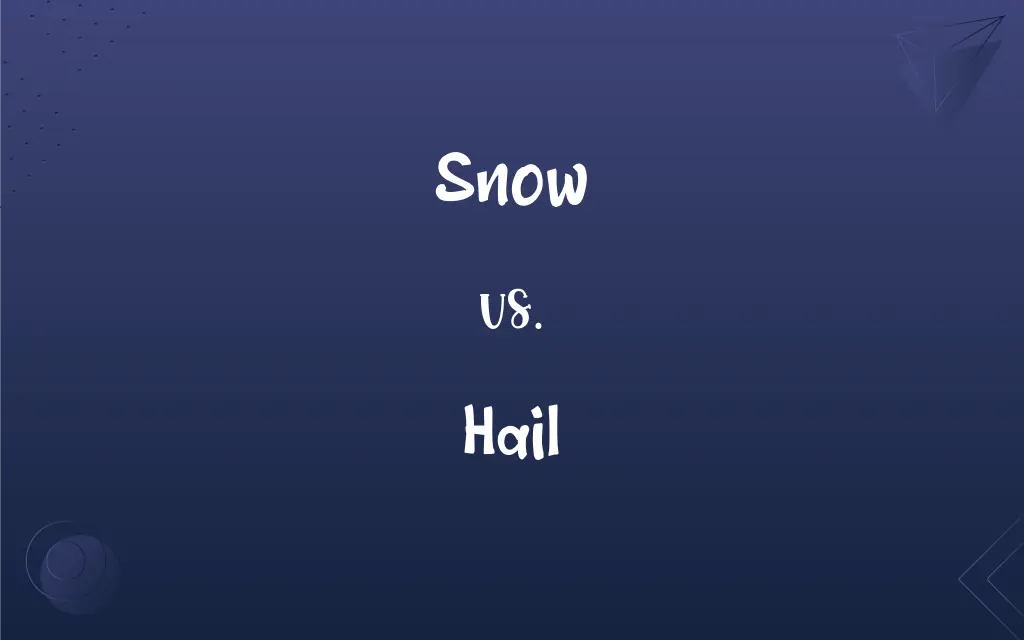Snow vs. Hail: What's the Difference?
Edited by Janet White || By Harlon Moss || Published on January 26, 2024
Snow is soft, frozen precipitation forming unique flakes, occurring in cold weather, while hail consists of hard, ice pellets formed in thunderstorms, regardless of ground temperature.

Key Differences
Snow forms in clouds when water vapor freezes into ice crystals, creating soft, unique flakes. Hail forms during thunderstorms when updrafts lift raindrops into extremely cold areas of the atmosphere, freezing them into hard pellets.
Snow is characterized by its soft, fluffy texture and intricate flake patterns. Hail is hard, spherical, or irregularly shaped ice pellets, varying in size, often causing damage upon impact.
Snow occurs in cold weather, typically at temperatures below freezing. Hail can occur in various temperatures, often during warmer weather associated with thunderstorms.
Snow accumulates gradually, creating a blanket of snow on surfaces, and is generally less damaging. Hail accumulates rapidly, often causing damage to crops, vehicles, and structures due to its hardness and velocity.
Snowfall can last for hours or days and is common in winter months in temperate climates. Hailstorms are usually brief and less frequent, occurring predominantly in spring and summer.
ADVERTISEMENT
Comparison Chart
Formation
Water vapor freezes into ice crystals.
Raindrops freeze into ice pellets in thunderstorms.
Texture
Soft, fluffy flakes.
Hard, spherical or irregular pellets.
Weather Condition
Occurs in cold, below-freezing temperatures.
Occurs in various temperatures, often during thunderstorms.
Impact
Gradual accumulation, less damaging.
Rapid accumulation, potentially damaging.
Frequency/Duration
Lasts hours to days, common in winter.
Brief and less frequent, mostly in spring/summer.
ADVERTISEMENT
Snow and Hail Definitions
Snow
Each snow particle is a unique snowflake.
Children caught snowflakes on their tongues.
Hail
Hail can cause damage to crops, vehicles, and buildings.
The hailstorm left dents in cars parked outside.
Snow
Snow can cover landscapes, creating a blanket of white.
The fields were blanketed in deep snow overnight.
Hail
Hail is a common phenomenon in thunderstorms.
The weather alert warned of possible hail during the thunderstorm.
Snow
Snowfall refers to the act of snow coming down from the sky.
Heavy snowfall caused schools to close.
Hail
Each piece of hail is referred to as a hailstone.
Hailstones as large as golf balls fell from the sky.
Snow
Snow is frozen precipitation in the form of ice crystals.
The forecast predicts snow for the weekend.
Hail
Hail consists of small ice pellets formed during thunderstorms.
The hail bounced off the car’s hood during the storm.
Snow
Snow is associated with winter weather and cold temperatures.
The first snow of the season covered the city in white.
Hail
A hailstorm is a storm where hail falls.
The hailstorm caused major disruptions in the city.
Snow
Frozen precipitation consisting of hexagonally symmetrical ice crystals that form soft, white flakes.
Hail
Precipitation in the form of spherical or irregular pellets of ice larger than 5 millimeters (0.2 inch) in diameter, usually associated with thunderstorms.
Snow
A falling of snow; a snowstorm.
FAQs
How does snow form?
Snow forms from water vapor freezing into ice crystals in clouds.
What temperature does it need to be for snow?
Temperatures below freezing are conducive for snow.
What is snow?
Snow is soft, frozen precipitation forming flakes.
How does hail form?
Hail forms from raindrops freezing in cold areas of thunderstorm clouds.
Can hail damage property?
Yes, hail can cause significant damage to property and vehicles.
Do snowflakes have unique patterns?
Yes, each snowflake has a unique pattern.
Can snow be used for recreation?
Yes, snow is popular for activities like skiing and snowboarding.
What is hail?
Hail is hard, ice pellets formed in thunderstorms.
Can hail occur in summer?
Yes, hail often occurs in summer during thunderstorms.
Is snow harmful?
Snow is generally harmless, but heavy snowfall can lead to disruptions.
Why is hail hard?
Hail is hard because it consists of compacted ice.
How long do hailstorms last?
Hailstorms are usually brief, lasting only a few minutes.
Can it snow when it's above freezing?
It's rare, but snow can occur in temperatures slightly above freezing.
What sizes can hailstones reach?
Hailstones can vary from pea-sized to as large as grapefruits.
What is a snowstorm?
A snowstorm is a weather event with heavy snowfall.
What is the largest hailstone recorded?
The largest hailstone recorded was about 8 inches in diameter.
Is snow always white?
Snow typically appears white due to the reflection of light.
Is hail always associated with thunderstorms?
Hail most commonly forms during thunderstorms.
What causes a blizzard?
A blizzard is caused by heavy snowfall and strong winds.
Does hail form in layers?
Yes, hailstones can form in layers as they circulate in the thunderstorm.
About Author
Written by
Harlon MossHarlon is a seasoned quality moderator and accomplished content writer for Difference Wiki. An alumnus of the prestigious University of California, he earned his degree in Computer Science. Leveraging his academic background, Harlon brings a meticulous and informed perspective to his work, ensuring content accuracy and excellence.
Edited by
Janet WhiteJanet White has been an esteemed writer and blogger for Difference Wiki. Holding a Master's degree in Science and Medical Journalism from the prestigious Boston University, she has consistently demonstrated her expertise and passion for her field. When she's not immersed in her work, Janet relishes her time exercising, delving into a good book, and cherishing moments with friends and family.






































































